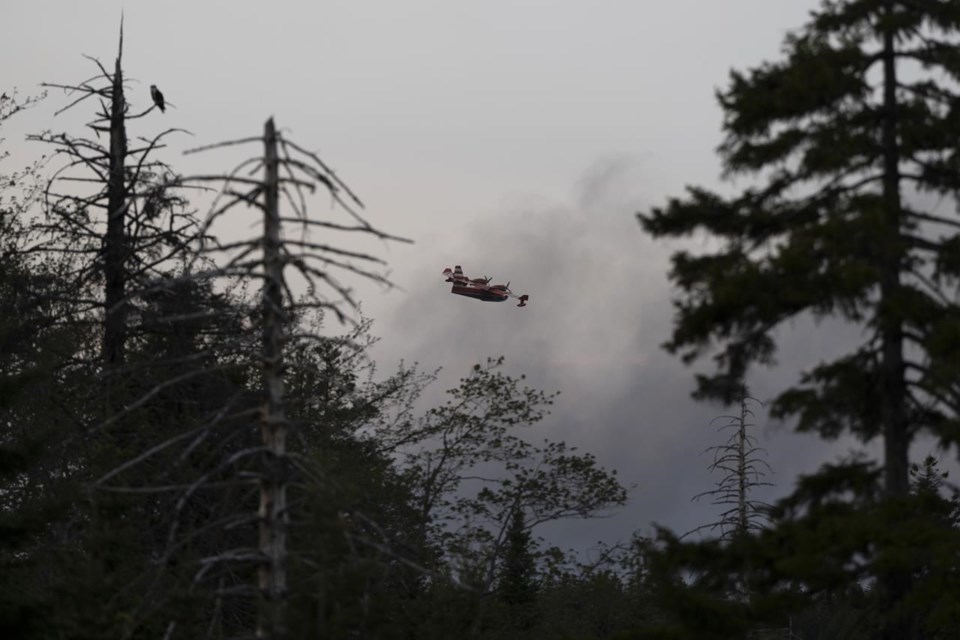The wildfire that ignited Sunday outside Halifax seemingly came out of nowhere, but experts say factors including a string of dry days, gusty winds and debris from post-tropical storm Fiona set the stage for the disaster.
John Clague, a professor of geosciences at Simon Fraser University in Burnaby, B.C., called the fire "a black swan event," something unexpected but with a significant impact. Raging fires such as the one that has damaged or destroyed an estimated 200 buildings are not usually associated with the Atlantic coast, which is known for high precipitation and moderate temperatures, he said.
But, he added, the number and severity of wildfires in general is increasing across the United States and Canada because of climate change.
"People didn't actually anticipate that something like this could happen," Clague said in an interview. “And they probably weren't fully ready for it.”
Authorities said the blaze, which started in Upper Tantallon, N.S., has so far not caused any deaths or injuries, but it has forced at least 14,000 people to seek shelter elsewhere as authorities ordered evacuations of a 100-square-kilometre area within a half-hour drive of downtown Halifax.
Kent Moore, an atmospheric physics professor at the University of Toronto, said the wildfire resulted from a combination of a dry spring and downed trees left behind by Fiona in September.
"April was the driest month on record at the Halifax airport. And those records go back at least 50 years," he said.
"When you have a dry spring … the ground is very dry. There's also fuel for these fires to get started on, because there was a lot of damage to the forest trees during Fiona. So there's lots of downed trees." High winds have also fanned the flames, he said. "Fires need oxygen to burn," he said. "When you have the wind blowing … it tends to help fires keep going."
This blaze is reminiscent of Alberta wildfires in Fort McMurray and Slave Lake, where homes were built on lands skirting woods, Clague said. The 2016 Fort McMurray wildfire destroyed more than 2,400 homes, while the 2011 Slave Lake blaze destroyed more than 400.
"These are all in forested areas," he said. "You don't normally think of it happening in a large city like Halifax, but in the case of Vancouver and Halifax and many other Canadian cities, you do have suburbs that extend out into the wildlands — out into the forest areas."
Moore also has a summer property in the Tantallon area, which has been affected by wildfire, and he hopes his house is safe. The development is on the fringes of a wooded area that has seen rapid construction over the past two decades, he said.
Most wildfires are caused by human activity, he noted, while just about five per cent are caused by lightning.
"Part of climate change is also the changes in the way we use the land," he said. "The impact of a wildfire is much more severe if there are people present. The changing way that we use the land is also contributing to the impact."
Clague said that if such a fierce fire can happen in Halifax, any other city in the country is vulnerable.
"I'm surprised, to be perfectly honest," he said. "I'm really surprised that this dry, warm weather has affected Nova Scotia to the point that something like this could happen. And to be perfectly honest, it frightens me."
Moore said it's "hard" to attribute such a wildfire to climate change because changes in rainfall patterns that caused tinderbox-like conditions are part of the natural variability. One of the causes of Fiona, on the other hand, he said could be linked to warming sea temperatures caused by climate change.
"The fact is that some years are warm, some years are cold, some years have lots of rain, some years have less rain," he said. "I don't think we can attribute these ones to climate change. But they can be attributed to our change in the way we use the land."
Clague agreed that Halifax wildfire can't directly be attributed to climate change, but he noted that unusual weather is becoming more common, not just in Canada but across the globe.
"And some of the events — really extreme events — seem to have the fingerprints of climate change all over them," he said.
Those living on the edge of forests should take steps to prepare for such fires in the future as they face a double threat from climate change and people wanting to live in wilderness away from city centres.
People should keep a closer eye on their properties, Clague said, from making sure they have fire-resistant roofs to removing excess vegetation and other flammable material that can fuel blazes.
Provinces will also have to step in and be serious about preventing these types of disasters. "Such fires are going to become more common in the future," he predicted.
This report by The Canadian Press was first published May 30, 2023.
Hina Alam, The Canadian Press



